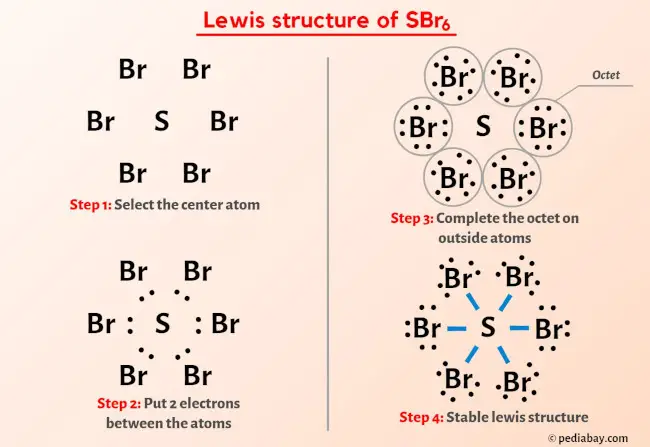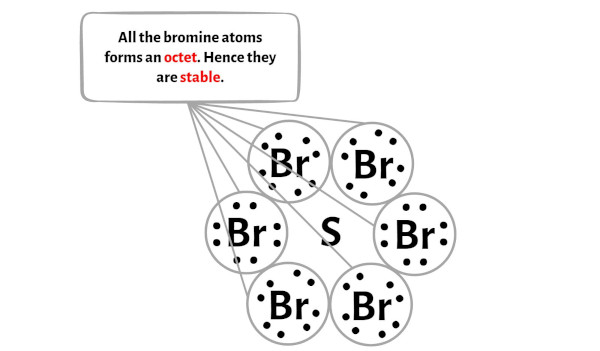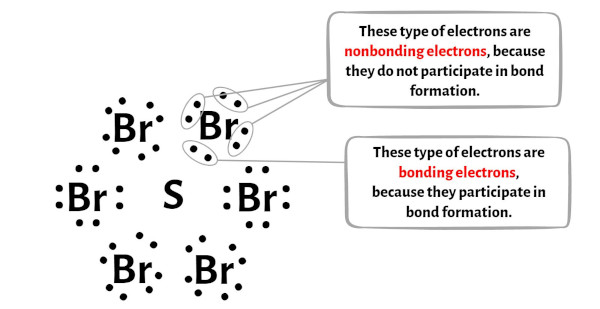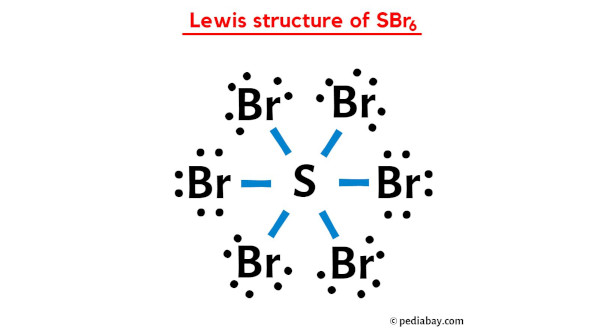
So you have seen the above image by now, right?
Let me explain the above image in short.
SBr6 lewis structure has a Sulfur atom (S) at the center which is surrounded by six Bromine atoms (Br). There are 6 single bonds between the Sulfur atom (S) and each Bromine atom (Br).
If you haven’t understood anything from the above image of SBr6 lewis structure, then just stick with me and you will get the detailed step by step explanation on drawing a lewis structure of SBr6.
So let’s move to the steps of drawing the lewis structure of SBr6.
Steps of drawing SBr6 lewis structure
Step 1: Find the total valence electrons in SBr6 molecule
In order to find the total valence electrons in a SBr6 molecule, first of all you should know the valence electrons present in sulfur atom as well as bromine atom.
(Valence electrons are the electrons that are present in the outermost orbit of any atom.)
Here, I’ll tell you how you can easily find the valence electrons of sulfur as well as bromine using a periodic table.
Total valence electrons in SBr6 molecule
→ Valence electrons given by sulfur atom:

Sulfur is a group 16 element on the periodic table. [1] Hence the valence electrons present in sulfur is 6.

You can see the 6 valence electrons present in the sulfur atom as shown in the above image.
→ Valence electrons given by bromine atom:

Bromine is a group 17 element on the periodic table. [2] Hence the valence electrons present in bromine is 7.

You can see the 7 valence electrons present in the bromine atom as shown in the above image.
Hence,
Total valence electrons in SBr6 molecule = valence electrons given by 1 sulfur atom + valence electrons given by 6 bromine atoms = 6 + 7(6) = 48.
Step 2: Select the central atom
For selecting the center atom, you have to remember that the atom which is less electronegative remains at the center.
Now here the given molecule is SBr6 and it contains sulfur atom (S) and bromine atoms (Br).

You can see the electronegativity values of sulfur atom (S) and bromine atom (Br) in the above periodic table.
If we compare the electronegativity values of sulfur (S) and bromine (Br) then the sulfur atom is less electronegative.
So here the sulfur atom (S) is the center atom and the bromine atoms (Br) are the outside atoms.

Step 3: Connect each atoms by putting an electron pair between them
Now in the SBr6 molecule, you have to put the electron pairs between the sulfur atom (S) and bromine atoms (Br).

This indicates that the sulfur (S) and bromine (Br) are chemically bonded with each other in a SBr6 molecule.
Step 4: Make the outer atoms stable
Now in this step, you have to check the stability of the outer atoms.
Here in the sketch of SBr6 molecule, you can see that the outer atoms are bromine atoms.
These outer bromine atoms are forming an octet and hence they are stable.

Also, in step 1 we have calculated the total number of valence electrons present in the SBr6 molecule.
The SBr6 molecule has a total 48 valence electrons and all these valence electrons are used in the above sketch of SBr6.
Hence there are no remaining electron pairs to be kept on the central atom.
So now let’s proceed to the next step.
Step 5: Check the stability of lewis structure
Now you have come to the final step in which you have to check the stability of lewis structure of SBr6.
The stability of lewis structure can be checked by using a concept of formal charge.
In short, now you have to find the formal charge on sulfur (S) atom as well as bromine (Br) atoms present in the SBr6 molecule.
For calculating the formal charge, you have to use the following formula;
Formal charge = Valence electrons – (Bonding electrons)/2 – Nonbonding electrons
You can see the number of bonding electrons and nonbonding electrons for each atom of SBr6 molecule in the image given below.

For Sulfur (S) atom:
Valence electrons = 6 (because sulfur is in group 16)
Bonding electrons = 12
Nonbonding electrons = 0
For Bromine (Br) atom:
Valence electrons = 7 (because bromine is in group 17)
Bonding electrons = 2
Nonbonding electrons = 6
| Formal charge | = | Valence electrons | – | (Bonding electrons)/2 | – | Nonbonding electrons | ||
| S | = | 6 | – | 12/2 | – | 0 | = | 0 |
| Br | = | 7 | – | 2/2 | – | 6 | = | 0 |
From the above calculations of formal charge, you can see that the sulfur (S) atom as well as bromine (Br) atom has a “zero” formal charge.
This indicates that the above lewis structure of SBr6 is stable and there is no further change in the above structure of SBr6.
In the above lewis dot structure of SBr6, you can also represent each bonding electron pair (:) as a single bond (|). By doing so, you will get the following lewis structure of SBr6.

I hope you have completely understood all the above steps.
For more practice and better understanding, you can try other lewis structures listed below.
Try (or at least See) these lewis structures for better understanding:
| HOFO Lewis Structure | BrF Lewis Structure |
| AlH3 Lewis Structure | MgF2 Lewis Structure |
| SbF3 Lewis Structure | Cl3- Lewis Structure |
Jay is an educator and has helped more than 100,000 students in their studies by providing simple and easy explanations on different science-related topics. He is a founder of Pediabay and is passionate about helping students through his easily digestible explanations.
Read more about our Editorial process.